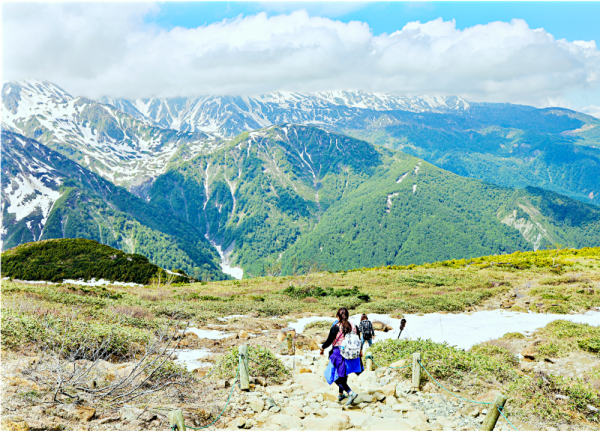Happy Mountain Day! A quick guide to enjoy climbing Japan’s yama-zing mountains

Happy Mountain Day (山の日 Yama-no-Hi)! Usually celebrated annually on 11 August, Mountain Day is Japan's newest public holiday, first observed in 2016. With over 70% of the country made up of magnificent mountains and majestic peaks, it's no surprise that Japan has a public holiday dedicated to them.
Meant to celebrate the mountains and appreciate their blessings, it is said that the date 11 August was chosen as the character for “8” (八 hachi) —August is the eighth month—resembles the shape of a mountain, while “11” looks like two trees.

Enjoying the view from along the ridgelines. (Image credit: Carissa Loh)
Mountain Day falls in summer, the perfect season to go hiking and mountain climbing, as daylight hours are longer, and temperatures are warmer. Many high peaks, including the 3,776m-high Mount Fuji (富士山 Fujisan) are best climbed in summer, as their summits are covered in snow in other seasons, and can reach below freezing temperatures at night even during summer.

Night sky from atop Mount Tsurugi. (Image credit: photoAC)
Mountain climbing is one of my favourite activities in Japan, and I’m always looking forward to planning my next mountain climbing trip. Japan’s mountains vary in elevation—you can enjoy some as day trips, and others as overnight or multi-day climbs. My personal favourite experiences are the tall mountains, which reward climbers with exceptionally vast and awe-inspiring views from the top; views that let you feel how amazing Mother Nature is. Getting to see thousands of stars sparkling in the night sky, or the deep orange sun rising above a fluffy sea of clouds are also magical experiences.
In this article, I’ll offer a quick guide on what to expect when climbing a mountain in Japan and staying overnight on the trail. Think you’re ready to go mountain climbing (山登り yamanobori) in Japan? Go for it!

Mount Shirouma, one of Japan’s 100 Famous Mountains. (Image credit: Carissa Loh)
Climbing Mount Fuji might be on the bucket lists of many tourists, but did you know that Japan has hundreds of other mountains for you to climb? Something that many local mountain climbing enthusiasts aim for is to hit the summits of Japan’s 100 Famous Mountains (百名山 hyakumeizan), a list of 100 mountains compiled by mountaineer Fukuda Kyuya in 1964.
Easy access

Most mountain trails have well-marked paths. (Image credit: Carissa Loh)
Although climbing a mountain might sound intimidating at first, Japan’s mountain climbing culture is well-developed, and most trails are well-marked with prominent signs. Even if you go climbing alone, you will likely encounter other many climbers along the trail. If you do see someone coming from the opposite direction, it’s common courtesy to say a small greeting like “Konnichiwa” (good day) or “Ohayogozaimasu” (good morning).
You don’t have to worry about transport either, as most trails have good public transport access, especially during summer. During the summer holiday season (July to August), many bus services from train stations to mountain climbing trail start points (登山口 tozanguchi) operate almost daily. Outside of summer, mainly from spring to autumn, they operate mostly on weekends and public holidays.
Mountain huts

Mountain hut at Karasawa Cirque. (Image credit: Carissa Loh)
A quintessential part of the mountain climbing experience is staying overnight at a mountain hut (山小屋 yamagoya). Most high-elevation mountains have a few yamagoya along the trails, where climbers can stay overnight, or take a break and grab a bite to eat before continuing on their climb. For safety reasons, if staying overnight you should generally aim to check-in by 15:00 or 16:00.

Examples of mountain hut exteriors and interiors. (Image credit: Carissa Loh)
Though simple, these mountain huts have futons, sheets, blankets, and pillows for sleeping. So far all the yamagoya I’ve stayed at have been pretty clean and comfortable. Most have a drying room where you can hang your wet clothes to dry. Toilets are mostly the compost or waterless types, and at higher elevations there are no showers due to limited water supply. Bathroom slippers and toilet paper are usually provided.

Some dinners I’ve had at yamagoya. (Image credit: Carissa Loh)
Most yamagoya also offer meal options like dinner and breakfast for guests, and also have a restaurant or café for non-staying climbers to purchase food, drinks, and snacks. Meals are warm, hearty and provide energy, and taste so good after a long day’s climb.
Many yamagoya also have tent spaces in their vicinity, so climbers can opt to stay in their own tents instead, to save on costs. As a tourist, unless you already own a tent, sleeping bag, and ground sheet that you are willing to pack and bring with you to Japan, I think yamagoya are more convenient and comfortable.

Goraiko from Mount Norikura. (Image credit: Carissa Loh)
Due to their high altitude locations, it’s absolutely magical to watch sunsets in the evenings, gaze at starry skies at night, and bask in gorgeous sunrises in the mornings. Did you know? There is a special word used for sunrises observed from high mountains or summits: goraikо̄ (ご来光).

Ridgelines offer panoramic views. (Image credit: Carissa Loh)
2D1N climbs are the most popular, especially over weekends, so you’ll find that Saturday night occupancy at yamagoya is highest. However, longer 3D2N or 4D3N climbs are not uncommon, especially during summer. On longer hikes, you can enjoy walking on the ridgelines between peaks, which offer spectacular, panoramic views of the surrounding mountains and plains below. I’ll admit that I don’t physically enjoy mountain climbing, but I always look forward to the stunning views at the peak—memorable views I know I can’t experience anywhere else.
What to bring for an overnight climb?
So, what do you need to bring for an overnight climb? It differs from person to person, but here are some basics and useful-to-have items. With many sports and outdoor stores around the country, it’s easy to shop for mountain climbing clothes and equipment in Japan.

What I packed for a 3D2N climb. (Image credit: Carissa Loh)
Basic must-haves
- Hiking shoes/boots (登山靴 tozankutsu): Mountain climbing trails are often rocky and uneven, so you’ll need proper hiking shoes that provide support and protect your feet.
- Rainwear (レインウェア reinwea): Mountain weather is ever-changing, especially at the different altitudes, so always be prepared for rain. It’s already cold at the summit, so getting wet will increase your chances of falling sick. Most people bring a waterproof outer shell jacket and pants, though some prefer ponchos or raincoats that cover the whole body. Don’t forget a rain cover (ザックカバー zakku-kabā) for your rucksack to keep your bag dry.
- Change of clothes: Even if you’re not going on an overnight hike, it’s good to bring an extra set of clothes in case they get wet or dirty. You should also bring warmer clothes for sleeping, as it can go below zero degrees at high elevations, even in summer.
- Water: It’s important to stay hydrated while climbing, so do bring enough water, keeping in mind how long your hike will be. Depending on the trail, there may be free water refill points, while others charge a small fee. Some people like to bring water bottles, while others (like me) prefer water systems, which are light and convenient to access.
- Sun protection: You’ll be exposed to a lot of direct sunlight and UV rays while climbing, so bring sunblock (日焼け止め hiyake-dome) and reapply unless you want to get sunburnt. Sunglasses, hats (帽子 bōshi) with UV protection, long-sleeved base layers are also good to have. Tip: don’t forget to protect your lips and the back of your hands.
- Map (地図 chizu): Whether it’s a hard-copy map or digital map, have one on hand to check directions and route times. Some of the more complicated trails have forked paths, so be careful to stay on course.
- Medicine: Always good to be prepared. If you’re hiking above 2,400m, there is a risk of altitude sickness, especially if you don’t take time to acclimatize.
- Powerbanks: Not all mountain huts let you use their power sockets. Some require a small fee, while some have limited slots on first-come-first-served, so it’s good to bring your own powerbank to charge your phones and cameras.

Find a rucksack you are comfortable with. (Image credit: Carissa Loh)
- Rucksack (ザック zakku): Most importantly, have a rucksack that you are comfortable with. As you will be climbing for hours while bearing the weight of your packed items, pick a rucksack that offers good support, adjusted to fit your body. You’ll be surprised by how correctly adjusted hip straps, sternum straps, and padded shoulder straps make weight distribution so much better.
Useful to have
While the items above are must-haves, these below are dependent on personal preferences and trip objectives, but I always have them on hand whenever I go mountain climbing:
- Trekking poles (ストック sutokku): These are good for rockier trails, for helping to keep balance, and for alleviating stress on the knees when descending.
- Gaiters (ゲイター geitā): Helpful for preventing small stones and sand from entering your shoes.
- Headlamp (ヘッドランプ heddoranpu): If you want to set off before dawn in order to catch the sunrise, or take a walk at night to see the stars, it’s good to bring a headlamp to see where you’re going.
- Emergency sheet: In case of emergencies. These help to trap body heat so that you stay warm.
- Ziplocs and dry bags: To compartmentalise and keep things dry. Also useful for keeping trash, as you’re supposed to bring your trash down with you when climbing mountains.
- Snacks (行動食 kōdōshoku): To replenish energy while on the move. It’s good to have some protein-filled snacks or food, especially if you’re doing longer distances.
- Compact towel/bandana: Especially useful for wiping sweat off your face.
- Hand sanitizers/sanitizing wipes: There are no showers or soap at most mountain huts…
To “summit” all up…

View of the Hotaka Mountain Range from Kamikochi’s Taisho Pond. (Image credit: Carissa Loh)
Mountain Day is all about appreciating Japan’s mountainous beauty and there’s no better way to celebrate it than going for a hike. But you don’t have to be an avid hiker or mountain climber to enjoy this holiday; you can still celebrate by enjoying the views of some of Japan’s beautiful mountains. Places like Kamikochi and Kawaguchiko offer fantastic mountain scenery without requiring much effort. However, if you do decide that you want to take up the challenge of climbing one of Japan’s breathtaking mountains, you won’t regret it!
Header image credit: Sue Lynn





